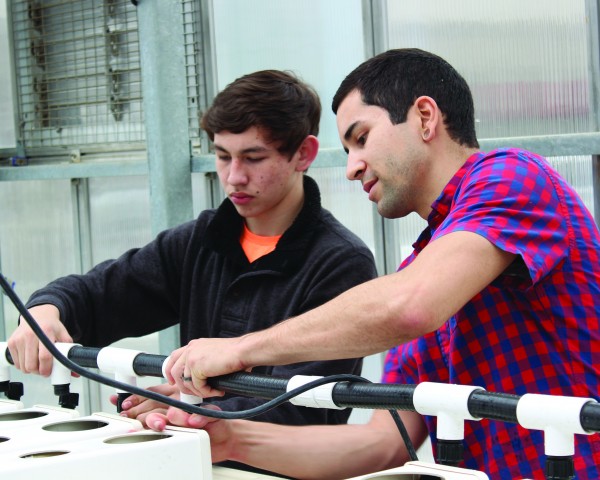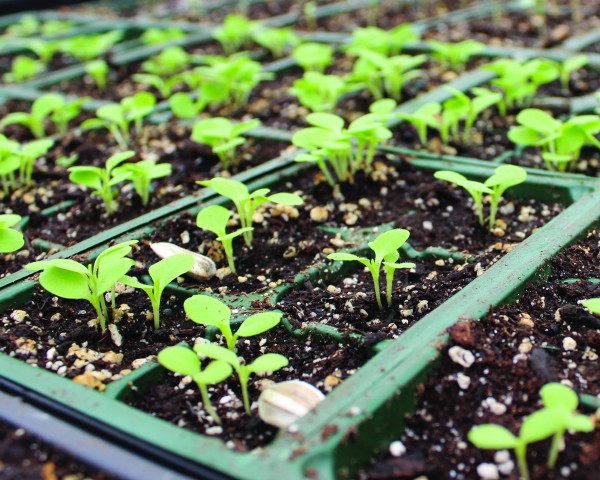
CHS student Anthony Toineeta and Joey Owle, Farm to School program coordinator, work in the greenhouse at Cherokee High School. (AMBLE SMOKER/One Feather photos)
By AMBLE SMOKER
ONE FEATHER STAFF
The agriculture program at the Cherokee High School recently harvested over 180 romaine lettuce crops that were planted in January. The lettuce was then prepared and served as a lettuce wrap to the students who wished to sample the harvest.
“We grew two kinds of lettuces hydroponically, butterhead and romaine,” said CHS agriculture teacher Billy Crain. “We put them out in January and harvested them this week.”
The agriculture class is a new course offering at Cherokee High School which gives students the opportunity to learn more on planting and growing crops. A major aspect of the program is learning horticulture and how to propagate seeds, prune, and take care of the plants. The program teaches students about hydroponics, where seeds are grown in water without soil. The class provides students with the opportunity to have a hands-on experience growing and cultivating crops for future sustainability.
The class is currently propagating seeds to be planted this spring in a community garden with a variety of vegetables including squash, cucumbers, tomatoes, onions, and more. The goal is to make the crops available in the summer to anyone in the community who doesn’t have access to fresh vegetables. A parent and teacher day is also in the works where activities will include harvesting the crops and fixing a meal on campus with the plants grown at the school.
“We’re hoping to get these kids engaged in the community and hold a community event here”, said Farm to School Coordinator Joey Owle. “We can bring in faculty and parents to help weed the beds, harvest the produce, and possibly share in a nice community meal from everything that we grow here.”
Classes are small, but every student is involved in the greenhouse where they are afforded the opportunity to see firsthand what horticulture is about. Outside of working hands-on in the greenhouse, the curriculum also involves classwork with lessons, tests, and a state test at the end of the year.
“This method enhances what students learn,” said Crain. “Kids can learn a whole lot better by doing hands-on activities. They’ll learn the application in the book but then the actual procedure in the greenhouse and outside when we start using our planters. It provides kids the opportunity to give back to their community.”
CHS student Anthony Toineeta stated, “I have learned how to propagate seeds and grow our own plants to have for ourselves. I’ve learned how to sustain our own food. Responsibility is probably the main thing and how to take care of our own stuff. They let us do our own thing and we plant our own seeds. We grow our own stuff. It’s for everybody, but it’s like it’s ours. We take care of it. Responsibility is the main thing that I think I have learned.
“When I get out of school, I want to have my own farm. I want to have livestock and plants. This is a good learning experience of how to grow my own food and food for my animals. I would like to have everything on my own, but I really want to come back to the school and give back to upcoming students that are doing the same things I’m doing.”
Fellow student, Jesse Crowe, said, “I learned mostly about how to plant the crops, the anatomy of the plants, and how they grow. I didn’t know about this stuff before I started this class and it was interesting to learn about.”
Cain added, “We invite anyone in the community to come by and see what we are doing. We invite parents to come by and see what their kids are learning. It doesn’t have to be parents. It can be anybody who doesn’t have access to vegetables, and they can come by to plant their own plants at no expense. We have over 200 tomato seeds in ten different varieties. We’ll also have squash, zucchini, cucumber, onion, and carrot plants, if they want plants, we’ll have them here.”





